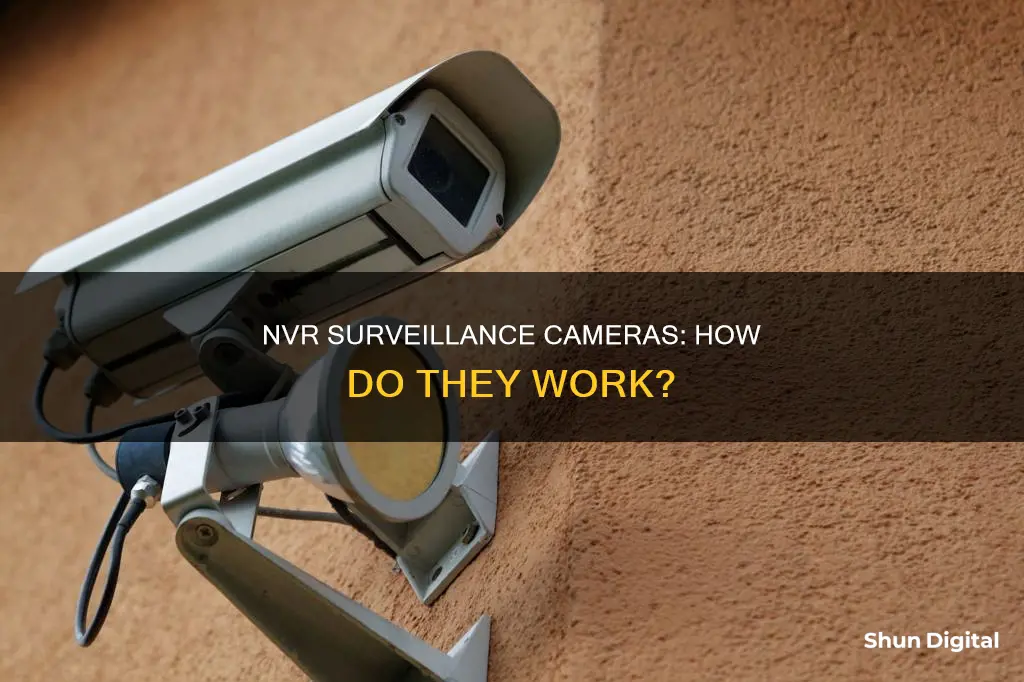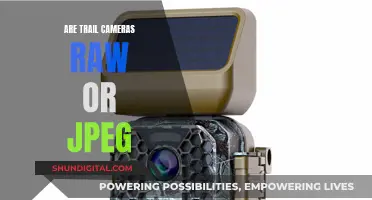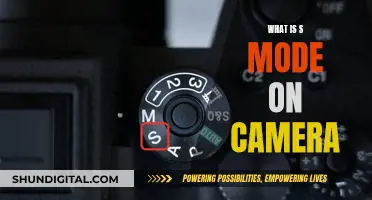
NVR stands for Network Video Recorder. NVRs are a type of video recording system used for security cameras. They are a relatively new technology, enabled by advanced IP or internet protocol cameras. NVRs can help improve safety, security and efficiency. They are often used by businesses that want around-the-clock remote and on-site surveillance that is scalable and flexible, without compromising quality. NVRs work with internet protocol (IP) cameras that can send and receive information across a network and record high-quality visual and audio footage. NVRs are more expensive than other options, such as DVR (Digital Video Recorder) systems, but they offer better picture quality, easier installation, increased flexibility and native support for audio on every camera that has a microphone.
| Characteristics | Values |
|---|---|
| Full Form | NVR stands for Network Video Recorder |
| Purpose | NVRs are used to capture, record, store and view video footage from security cameras |
| Compatibility | NVRs are compatible with IP cameras, also known as internet protocol cameras |
| Data Processing | NVRs process data at the camera, not the recorder |
| Storage | NVRs can store data on hard drives, mass storage devices or cloud storage |
| Camera Placement | NVRs offer flexibility in terms of camera placement due to wireless capabilities |
| Video Quality | NVRs offer higher-quality video than DVRs, typically between 2MP (1080p) to 12MP (4K) |
| Frame Rate | NVRs offer a higher frame rate than DVRs, typically 30 fps |
| Audio | NVRs can record audio along with video |
| Remote Access | NVRs allow remote access to footage via the internet |
| Installation | NVRs are generally easier to install due to the use of Ethernet cables |
| Cost | NVRs are more expensive than DVRs due to the advanced technology and capabilities |
What You'll Learn

NVR vs. DVR
NVR stands for Network Video Recorder, while DVR stands for Digital Video Recorder. Both systems record and store video data transmitted from security cameras, but there are some key differences between the two.
DVR Security Systems
DVR systems use analogue cameras, which transmit raw video signals to the DVR along coaxial cables. The DVR then processes this signal into a digital format for storage and remote viewing. DVR systems are generally cheaper than NVR systems and are a good option for those on a tight budget. They are also a good choice for properties with existing coaxial connections from a previous security system.
However, one of the drawbacks of DVR systems is that they require bulkier coaxial cables, which can make installation more challenging, especially in tight spaces. Additionally, the image quality of analogue cameras is typically lower than that of IP cameras used in NVR systems.
NVR Security Systems
NVR systems, on the other hand, use newer technologies such as internet connectivity. They capture video from IP (internet protocol) cameras, which can process video data at the source and send it to the NVR over an ethernet cable or wirelessly via Wi-Fi. NVR systems offer higher video resolution and can provide features such as audio recording, licence plate recognition, facial recognition, and motion detection.
NVR systems are generally more expensive than DVR systems, but they offer greater flexibility and scalability. They are also easier to install, as ethernet cables are thinner and more flexible than coaxial cables. NVR systems are a good choice for newer buildings where ethernet cables can be easily installed, and for businesses that require advanced surveillance capabilities.
In summary, the choice between NVR and DVR security systems depends on specific needs and budget constraints. DVR systems are more cost-effective and suitable for basic security needs, while NVR systems offer superior quality, flexibility, and scalability, making them ideal for businesses or properties requiring advanced surveillance.
Kami Wire-Free Camera: How Long Does the Battery Last?
You may want to see also

How NVR camera systems work
NVR camera systems are made up of three parts: cameras, a network, and the NVR.
Cameras
There are many different types of security cameras on the market, including analog cameras and wire-free Wi-Fi cameras. NVRs are generally used in combination with IP cameras, which can be connected using an Ethernet cable or Wi-Fi. IP cameras that use an Ethernet connection are called Power over Ethernet (PoE) cameras. Ethernet cables power the camera and transfer data to the NVR, making installation easier and more flexible.
IP cameras are capable of encoding and processing video data themselves, then streaming it to the NVR for storage and remote viewing. They can record and transmit both video and audio data, and support advanced features such as facial recognition, motion detection, and night vision capabilities.
NVR
A key part of an NVR security camera system is the NVR itself, which is not a camera. Some NVRs are devices that contain hard drives, while others are cloud-based, leveraging cloud storage and technology. All NVRs perform the same function: they receive video footage through a network data connection and store footage for later review. They contain several Ethernet ports, allowing multiple cameras to be hooked up.
Network Connection
IP security cameras connect to the NVR using wired or wireless connections. Typically, if it’s a wired connection, a camera connects to the NVR via an Ethernet cable. Wireless connections offer more flexibility in camera placement but may be less reliable and secure.
Viewing Footage
Once the footage from IP cameras reaches the NVR, it can be stored or viewed remotely, online or offline, using mobile devices and desktop applications. Software is usually packaged with NVR devices and typically includes camera system setup, onboarding, and viewing capabilities for playback.
For more advanced features such as real-time alerts and search tools, an advanced video management system (VMS) is required. This can be a standalone tool or sometimes the software component of the NVR.
Understanding Panoramic Photography: Pano Mode in Cameras
You may want to see also

Benefits of NVR camera systems
NVR camera systems offer a range of benefits, especially when compared to their DVR counterparts. Here are some of the advantages of NVR camera systems:
High-Resolution Image Quality
NVR systems typically offer superior image quality to DVR systems. While DVR systems use analog cameras with lower resolutions and frame rates, NVR systems use IP cameras that can offer much higher resolutions. Higher-end IP cameras can provide Super HD resolution, resulting in crisp and clear video quality. Additionally, IP cameras often have features like wide dynamic range (WDR) to optimise video quality in varying lighting conditions and night vision capabilities for low-light environments.
Increased Flexibility
NVR systems provide businesses with greater flexibility in terms of camera placement and mounting locations. IP cameras used in NVR systems can be installed almost anywhere, especially when combined with wireless connectivity. This flexibility allows businesses to strategically place cameras to maximise coverage and effectiveness.
Advanced Features and Security
IP cameras in NVR systems often include advanced features such as facial recognition, motion detection, and night vision capabilities. These features can enhance security protocols and enable more proactive safety measures. When paired with cloud storage solutions, NVR systems can also be configured with additional security measures like password protection, two-step verification, and encryption to prevent unauthorised access.
Scalable Storage
NVR systems are cloud-compatible, allowing for scalable storage solutions. Businesses can easily expand their storage capacity by adding additional servers, ensuring that they never run out of space for their surveillance footage. This scalability makes NVR systems ideal for businesses that require 24/7 surveillance without the worry of storage limitations.
Remote Access
Cloud storage in NVR systems enables remote access to footage for authorised users. Business owners and surveillance staff can securely view footage from any location, at any time, using their preferred devices. This remote access capability is particularly valuable for businesses with multiple locations or those seeking greater flexibility in managing their security operations.
Power over Ethernet (PoE)
NVR systems that utilise Ethernet cables can provide both internet connectivity and power to IP cameras through a single cable. This simplifies the wiring process, reducing the amount of cabling required for the security system. PoE technology streamlines installation and reduces the overall complexity of the system.
Best Camera Battery Chargers: De-A45 Edition
You may want to see also

Drawbacks of NVR camera systems
NVR camera systems, also known as network video recorders, are a relatively new technology that offers many benefits, such as enhanced security, remote access, and high-quality video and audio. However, there are some drawbacks and limitations to be aware of when considering this type of surveillance system. Here are some of the key disadvantages of NVR camera systems:
High Upfront Cost
NVR systems tend to be more expensive than comparable DVR (digital video recorder) systems. The advanced technology and features of NVR components come at a higher price. While NVR systems offer improved capabilities, the cost may be a significant factor for budget-conscious consumers or those seeking a more straightforward security solution.
Limited Camera Compatibility
NVR systems typically require cameras from the same manufacturer to ensure compatibility. This limitation can make it challenging to purchase multiple IP cameras that work seamlessly with a specific NVR system. In contrast, DVR systems usually offer greater flexibility, allowing for the mixing and matching of different camera brands and models.
Cybersecurity Risks
Since NVR systems are connected to the internet, they are potentially vulnerable to hacking and other cybersecurity threats. This exposure to online risks means that administrators must regularly monitor network security and implement robust protections, such as encryption and multi-factor authentication.
Short Lifespan
The components of NVR systems, particularly hard drives, have relatively short lifespans. For example, NVR system hard drives typically last for 3-8 years, which is shorter than the lifespan of comparable DVR system components. This shorter lifespan may result in more frequent replacements and higher maintenance costs over time.
Installation Challenges
While NVR systems offer wireless options that provide flexibility in camera placement, they are not without their installation challenges. NVR systems require a stable internet connection, and wireless setups rely on Wi-Fi, which can be less reliable than wired connections. Interference and signal loss can impact the performance of wireless NVR systems, compromising the quality of recordings.
Power Requirements
NVR systems that utilise Power over Ethernet (PoE) technology require a reliable power source. Each camera needs to be powered, and a stable power supply is essential for the system to function effectively. This power requirement may limit installation options or necessitate additional power infrastructure in some cases.
Charging a VTech Camera: A Step-by-Step Guide
You may want to see also

NVR camera system alternatives
A network video recorder (NVR) is a computer system that records video footage and stores it on a hard disk, mass storage device, or cloud storage. NVRs are typically used in combination with internet protocol (IP) cameras to create a video surveillance system.
There are several alternatives to NVR camera systems, including:
- Digital Video Recorder (DVR): DVRs are traditional security systems that use analogue cameras, coaxial cables, and a DVR recorder. DVRs are generally less expensive than NVRs but offer lower video quality and less flexibility in terms of camera type and mounting options.
- Cloud-based Solutions: Cloud-based alternatives offer remote access, cost-effectiveness, easy scalability, and secure storage. They function similarly to NVRs but are accessed through the cloud, providing greater accessibility and reducing maintenance costs.
- Hybrid Cloud Solutions: These systems combine on-premises storage with cloud-based functionality, offering the benefits of both local and cloud-based solutions.
- Self-Hosted Solutions: Options like ZoneMinder, Shinobi, Blue Iris, and MotionEye offer free or low-cost alternatives to NVRs but may require more technical expertise for setup and maintenance.
- Other Commercial Alternatives: Commercial alternatives like NX Witness, Milestone Xprotect, and Unifi Protect offer feature-rich and user-friendly NVR solutions, often with dedicated mobile apps and advanced functionality.
The Evolution of Cameras: A Historical Timeline
You may want to see also
Frequently asked questions
NVR stands for Network Video Recorder. It is a computer system that records video footage from digital cameras and stores it on a hard disk, mass storage device, or cloud storage. NVRs are paired with digital internet protocol (IP) cameras to create a video surveillance system.
An NVR camera system consists of three main parts: cameras, a network, and the NVR itself. The cameras capture and process video data, which is then transmitted to the NVR recorder for storage and remote viewing. The NVR does not process the video data but receives and stores it for later review.
NVR surveillance cameras offer several advantages, including high-resolution image quality, increased flexibility in mounting locations, advanced features such as facial recognition and motion detection, scalable storage through cloud compatibility, and remote access to footage via the internet.
The cost of an NVR surveillance camera system can vary depending on the number of cameras and the specific features included. However, NVR systems are generally more expensive than DVR (Digital Video Recorder) systems due to the advanced technology and capabilities of the cameras.
When choosing an NVR camera system, consider factors such as your budget, the number of cameras needed, the desired features (e.g., facial recognition, motion detection), the compatibility with your existing infrastructure, and whether you require cloud storage or local storage. Additionally, ensure that the selected NVR recorder supports the manufacturer, resolution, and bitrate of the cameras.







